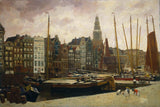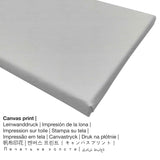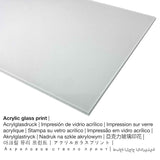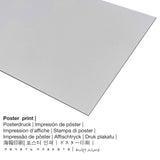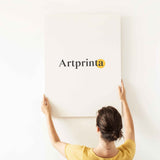George Hendrik Breitner, 1903 - The Damrak, Amsterdam - ọmarịcha nka
Ụtụ gụnyere. Mbupu gbakọrọ na ndenye ọpụpụ.
Nkọwa zuru oke sitere na ụlọ ngosi nka (© nwebiisinka - Rijksmuseum - Rijksmuseum)
Since 1889 Amsterdam’s Centraal Station has blocked the link between the Damrak (a straight stretch of the Amstel River) and the IJ (the city’s former bay). Once an open body of water, the Damrak was turned into an inner harbour. Here Breitner depicted the houses on the Warmoesstraat and the Oudekerk tower. He used a photograph, which included the Koopmansbeurs (Commodity Exchange) – then under construction. In his painting, this building was completely omitted.
Data ndabere gbasara ọrụ nka
| Aha nka nka: | "The Damrak, Amsterdam" |
| Nhazi: | sere |
| Nhazi nka: | nkà nke oge a |
| Century: | 20th narị afọ |
| Year: | 1903 |
| Afọ nka: | karịa afọ 110 |
| Ụlọ ihe ngosi nka / mkpokọta: | Rijksmuseum |
| Ebe ngosi nka: | Amsterdam, Netherlands |
| Ebe nrụọrụ weebụ ihe ngosi nka: | Rijksmuseum |
| Ụdị nka nka: | ngalaba ọha |
| Site n'aka: | Rijksmuseum |
Ozi ndabere na onye na-ese ihe
| aha: | George Hendrik Breitner |
| A makwaara dịka: | Breitner Georg Hendrik, Breitner George Hendrik, George Hendrik Breitner, ברייטנר ג'ורג' הנדריק, Breitner, Breitner Georges H., Breitner G. H. |
| okike nke onye nka: | nwoke |
| Obodo onye nka: | Dutch |
| Ọrụ onye na-ese ihe: | onye na-ese foto, onye na-ese ihe |
| Obodo obibi: | mba netherland |
| Otu nka: | omenkà nke oge a |
| styles: | Mmetụta |
| Ndụ: | 66 afọ |
| Afọ ọmụmụ: | 1857 |
| Afọ nwụrụ: | 1923 |
Ngwaahịa a
| Nkewa ngwaahịa: | nka nka |
| Usoro mmeputakwa: | dijitalụ mmeputakwa |
| Usoro mmepụta: | Mbipụta UV / dijitalụ |
| Ihe ngosi: | German mere |
| Ụdị ngwaahịa: | na mmepụta ihe |
| Ngwaahịa were: | mgbidi gallery, foto mgbidi |
| Nhazi nka nka: | usoro odida obodo |
| Ụdị anya: | ogologo: obosara 3:2 |
| Mmetụta akụkụ: | ogologo bụ 50% ogologo karịa obosara |
| Nhọrọ ihe onwunwe: | Mbipụta iko acrylic (nwere ezigbo mkpuchi iko), mbipụta ọla (aluminium dibond), mbipụta akwa akwa, mbipụta akwụkwọ mmado (akwụkwọ kwaaji) |
| Kanvas n'elu etiti ihe ndọtị (mbipụta akwa akwa): | 30x20cm - 12x8", 60x40cm - 24x16", 90x60cm - 35x24", 120x80cm - 47x31", 150x100cm - 59x39" |
| Mbipụta iko acrylic (nke nwere ezigbo mkpuchi iko): | 30x20cm - 12x8", 60x40cm - 24x16", 90x60cm - 35x24", 120x80cm - 47x31" |
| Mpempe akwụkwọ mmado (akwụkwọ kwaaji) nha: | 60x40cm - 24x16", 90x60cm - 35x24", 120x80cm - 47x31" |
| Mpempe akwụkwọ Dibony (ihe alumnium) nha: | 30x20cm - 12x8", 60x40cm - 24x16", 90x60cm - 35x24", 120x80cm - 47x31" |
| Igwe onyonyo: | adịghị |
Ihe ndị a na-ahọrọ
Anyị na-enye ihe dị iche iche dị iche iche na nha maka ngwaahịa ọ bụla. Họrọ nha na ihe kacha amasị gị n'ime nhọrọ ndị a:
- Mbipụta kanvas: A canvas print, not to be confused with a painting on a canvas, is a digital copy printed from an industrial printing machine. A canvas creates a familiar and comfortable feeling. How do I hang a canvas on the wall? Canvas Prints have the great advantage of being low in weight. That means, it is easy and straightforward to hang the Canvas print without additional wall-mounts. Because of thatcanvas prints are suited for all types of walls.
- Akwụkwọ mmado na ihe kwaaji: Our poster print is a printed sheet of cotton canvas paper with a nice texture on the surface. Please note, that depending on the size of the poster print we add a white margin of something between 2-6cm around the work of art, which facilitates the framing with your custom frame.
- Mbipụta nke aluminom: Aluminium Dibond prints are metal prints with a true effect of depth. A direct Direct Print on Aluminum Dibond is the perfect start to fine art reproductions with aluminum. For your Direct Aluminium Dibond option, we print your selected artpiece onto the surface of the white-primed aluminum material. The white & bright parts of the original work of art shine with a silky gloss but without any glare.
- Mbipụta iko acrylic (nke nwere ezigbo mkpuchi iko): A glossy print on acrylic glass, which is often referenced as a plexiglass print, will turn your chosen original artwork into stunning décor. The great advantage of a plexiglass fine art print is that contrasts plus painting details will be recognizeable because of the delicate tonal gradation. The plexiglass protects your selected art replica against light and heat for up to six decades.
Banyere mbipụta nka "The Damrak, Amsterdam"
The Damrak, Amsterdam is a work of art created by the male Dutch artist George Hendrik Breitner in the year 1903. Nowadays, this work of art can be viewed in in the digital collection of Rijksmuseum. We are delighted to mention that the public domain piece of art is included with courtesy of Rijksmuseum.: . N'elu nke ahụ, nhazi nke mmepụta dijitalụ bụ odida obodo na a akụkụ ruru nke 3: 2, nke pụtara na ogologo bụ 50% ogologo karịa obosara. George Hendrik Breitner was a male photographer, painter of Dutch nationality, whose art style can primarily be assigned to Impressionism. The Dutch artist lived for 66 afọ Amụrụ na 1857 wee nwụọ na 1923.
Ederede iwu: We try our best in order to describe the art products as accurate as we can and to showcase them visually on the various product detail pages. Still, the tone of the print materials, as well as the imprint may differ to a certain extent from the representation on your device's screen. Depending on your settings of your screen and the nature of the surface, not all color pigments can be printed one hundret percent realistically. Bearing in mind that all fine art prints are printed and processed by hand, there might also be slight discrepancies in the exact position and the size of the motif.
Ederede a bụ ikike ọgụgụ isi ma chekwaa ya site na nwebisiinka © - Artprinta.com (Artprinta)

